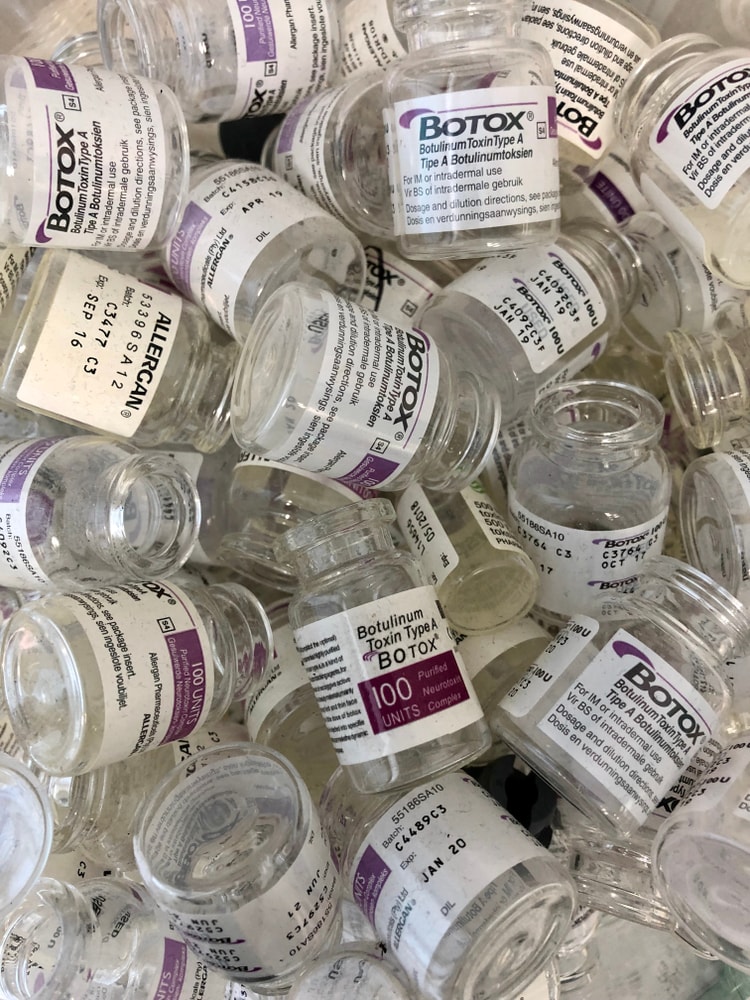
15 Misconceptions About Botox: The Truth
- August 10, 2019


Botox – a name synonymous with “youth in an injection” – conjures up images that horrify in one moment, incite laughter in another, and inspire people in the next.
Expressionless, cold looks are what people think of when Botox is mentioned.
Horror stories are aplenty. One notable account that comes to mind is Eric and Bonnie Kaplan‘s close brush with death; after unknowingly receiving home-made concoctions of botulinum toxin injections from a friend.
Humorous “accidents” are also common among high profile individuals. Think Rosmah Mansor, wife of ex-PM of Malaysia.
But what’s not highlighted by the media are the other millions of successful Botox injections performed per year. So rather than paint it over with a broad, negative stroke, let this article dispel your misconceptions about the treatment. Going to a reputable, if not the best aesthetic clinic in Singapore would definitely be preferred to minimise the possibilities that Botox is wrongly administered.
[What Botox can do for you – the ultimate guide]
The dosage of Botox used in cosmetic treatments is low and safer than compared to those used for therapeutic purposes.
As Swiss physician and chemist Paracelsus so eloquently puts it, “The Dose Makes the Poison”; a substance that contains toxic properties can cause harm only if administered in a high enough concentration.
Anything – even water and oxygen – can be toxic, if too much is ingested or absorbed into the body.
But what about the Botulinum Toxin drug in Botox?
It is one of the most toxic substances known to man and is derived from Clostridium botulinum, a very common organism found in the natural environment. However, with common hygiene practices such as cooking of food, proper sanitisation and avoidance of spoiled food, botulism poisoning is well controlled.
In Botox cosmetic, the U.S. Food and Drug Administration has strict protocols and processes that limit it to professional use.
In Singapore, only doctors are given the license to use the product. If it’s your first time, please check that the doctors in your aesthetic clinic in Singapore have that license displayed.
FACT: Comical frozen looks are often the result of the overuse of Botox. The doctor’s inexperience in handling the product can be blamed in some cases; often times the wrong dosage was used or the drug was incorrectly placed or injected. A follow-up appointment is important.
Correction of a weird look is possible in some cases such as “Spock brows” or the overarching of the eyebrows. A small dose of Botox can be administered to relax the muscles pulling the brows upwards.
However, at other times, botched treatments can also be attributed to the patient.
This may be a tough pill to swallow, but some patients have the impression that the more botulinum toxin one gets, the younger the patients look.
Hence, they often have a need for more Botox to be injected, even though this may lead to aesthetically unpleasant, or even dangerous results. This is, unfortunately, a misconception that unethical doctors may prey upon; all for extra profit.
“While a professional doctor will be able to expertly assess the number of Botox units you’ll need,” says Dr. Kelvin Chua, medical director of SL Aesthetic Clinic, “…an ethical doctor will also have to manage your expectations with what the treatment can and should realistically and optimally achieve.”
At SL Aesthetic Clinic, our doctors will not compromise on our professional code of conduct, and will not perform any procedures if the patient feels that More is Better. We aim to produce results that are naturally beautiful with unhindered facial expressions; not frozen caricatures.
Often, Botox and fillers are used together in treatments to achieve even greater results than when they’re used alone.
FACT: They are not. Fundamentally, Botox and fillers operate on very distinct mechanisms.
Botox is a neuromodulator; it works by blocking nerve signals and hence decrease muscle action. This reduces wrinkling and lines on the skin.
Fillers, on the other hand, are exactly what its name suggests; they fill up gaps in areas where they’re used, such as areas of volume loss, or to enhance certain areas of the face or body.
Sometimes, these two treatments can be used, whether on their own or combined synergistically by doctors to achieve the same or even greater result.
One such example is in treating horizontal forehead lines. Botox is used to prevent the lines from taking root, while fillers are used to fill up and even out any lines that are already there in the skin.
[Read more about the differences and similarities in the use of Botox and fillers.]
FACT: Botox is just one of many brands of Botulinum Toxin. Other brands include Dysport and Xeomin, which are also available for use in Singapore.
The reason why people associate Botulinum Toxin treatments with the Botox brand is that the brand is the first of its kind, and is marketed and branded as such.
The products from all of these brands are made from Clostridium botulinum, but from different strains, featuring different molecular structures, and work on different parts of the nerve.
But what does this mean for the end-user like you? It means that the dosage differs between brands.
1 unit of Botox does not equate to 1 unit of Dysport, Xeomin or vice versa. Plus, patients also respond to each brand differently; the duration of effect will hence vary.
SL Aesthetic Clinic uses predominantly Botox and Xeomin for a variety of concerns.
No amount of Botox can remove static, or “permanent” wrinkles. Here, fillers are better at resolving them!
FACT: There are two types of wrinkles – dynamic and static. Botox treats dynamic wrinkles, which form with muscle movement such as Crows’ Feet.
It cannot help with static wrinkles; lines that form due to sun exposure and the natural aging process, such as those in the corners of the mouth.
With that said, however, dynamic wrinkles can turn into static lines after many years, which is why Botox can be used as a preventive anti-aging measure at younger ages.
Static wrinkles can be resolved using a combination of other treatments such as dermal fillers, thread lifting, lasers, or chemical peels.
Plus, Botox can also be used for other cosmetic benefits, such as slimming the jaw muscles, lifting the brows, lowering or raising the chin, reducing your skin’s oil production, controlling sweat production and more.
FACT: Stopping Botox treatment means you will lose the preventive muscle relaxing effect it brings, but it will not worsen them; your wrinkles will simply slowly return to how they were before being treated.
FACT: Botox injections feel like little ant bites. The needles used in Botox injections are very fine and thin, which means you may only feel a little sting if any. The procedure is well-tolerated by most patients, especially with the application of numbing cream although this is usually not required. Many of our patients do not have numbing cream applied before undergoing Botox treatments.
With little to zero downtime, Botox treatments are popularly referred to as “lunchtime procedures” where patients typically return to their daily activities right after treatment.
We do, however, advise against alcohol consumption on the day of treatment itself.
FACT: Botox does not contain any addictive properties nor cause anyone to become addicted to it. What people get used to is the cosmetic results that they see. Patients can always stop treatment at any point in time without any clinical withdrawal effects.
The beauty of Botox is that it’s not permanent. It’s meant to be a softer way to delay aging so that you can age gracefully, not artificially and totally prevent it.
FACT: Results last between 3 to 6 months, depending on the individual response to Botulinum toxin, lifestyle, the dosage used, and treated area.
One thing to note, however, is that with prolonged use, results typically last longer with each subsequent treatment. This is because of your muscles atrophying from lack of activity.
FACT: Unlike other cosmetic treatments such as fillers, it takes time for Botulinum toxin to work.
Depending on the treated area, the toxin slowly blocks nerve signals on the treated muscles. This typically starts within the first 3 days, with more pronounced results in a week or even a month.
The rule of thumb is that the larger the muscle treated, the longer the result will fully realise.
Botox is actually more effective for those whose wrinkles are not severe and static.
FACT: Botox is used by a wide range of demographics and as a solution to a plethora of concerns.
It is certainly popular with patients looking to reduce the appearance of wrinkles – a concern coincidentally belonging to older patients.
Many patients of varying ages also seek the treatment to temporarily [slim and sharpen their jawlines] for that coveted V-shaped face.
Younger patients also benefit from the procedure as a form of preventive aging medicine – halting the formation of lines on the skin and reducing the need for future, more aggressive treatments.
FACT: Women are no longer the only ones expected to look good and take care of their appearances.
Today, men have increasingly felt the need to upkeep their appearances. Botox, lasers, fillers, or even liposuction are now even considered by men; if only to sell themselves better in the dating scene or remain competitive in the job market.
FACT: It was first developed by ophthalmologist Alan Scott to treat strabismus, also known as crossed eye, and other misalignments of the eyes. It has since been adapted for a multitude of therapeutic treatments such as migraine headaches, chewing problems (bruxism), drooling, hair loss, excessive sweating and more.
It was only in 2002 that the USFDA approved its use for cosmetic purposes.
Botox remains to this day a versatile drug as scientists continue to discover novel applications in medicine and beyond.
FACT: Most patients do not need more units of the drug with each subsequent treatment. In fact, long-term users typically require lesser units of Botox over many years of treatment. This is due to the treated muscles atrophying from lack of activity.
For example, if you do not use your legs for decades, your leg muscles would eventually shrink and weaken. The same can be said for muscles treated with Botox over a long period.
“With regular, uninterrupted treatment of Botox over many years, eventually the muscle will atrophy from lack of use,” says Dr. Gabriel Wong.
This does not mean that your entire face will shrink and atrophy; the effects of Botox are localised at where its injected. Only the muscles treated will atrophy, leaving other muscles at their original volume.
However, a small percentage of Botox users develop resistance to the drug. Their bodies develop antibodies that break down the drug easier and faster.
In such cases, more Botox may be required with each treatment. Botulinum toxin brand Xeomin, on the other hand, claims to be able to circumvent this problem due to its “purer” form of the drug, although the verdict is still not out on this front.
FACT: Botox is becoming increasingly available to more and more people than ever before, with prices becoming even more competitive than ever.
This is also exactly the reason why you should practice due diligence and research about the procedure, the clinic, and the doctor. Like what you are doing now.
If the price is too good to be true, it almost always is. Botox prices in Singapore vary by what concerns you have, as with all surgical or non-surgical facelifts in Singapore. The cost can range between $300 to over $1,000 SGD.
[07 May 2021] A blog post by Dr. Wei Xiang

Dr Wei Xiang has been heavily involved in the arts throughout his life. During his formative school years, he studied fine arts under the prestigious Art Elective Programme, where he developed his artistic talent and creative expression across various media, including painting, charcoal, digital media and photography.
After graduating from the Yong Loo Lin School of Medicine in 2014, Wei Xiang pursued postgraduate surgical training in a residency programme, where he honed his surgical skills over the years. His artistic side remained strong, and he constantly yearned to express a greater aesthetic element in his work. In 2019, he left his surgical career in search of his calling.
A fateful encounter with Dr Kelvin Chua brought Wei Xiang into the world of Aesthetic Medicine. It was in Aesthetic Medicine where Wei Xiang found his “ikigai” of sorts. Under Kelvin’s mentorship, Wei Xiang grew steadily and became adept at a wide range of aesthetic procedures including Botox, fillers, lasers, HIFU, Thermage, Ultherapy and PicoCare Laser. His keen eye for beauty, coupled with his steady hands, allows him to bring out the best in his patients.
Wei Xiang occasionally still creates artwork in his free time, when he is not spending time with his wife and daughter, or jamming and making music.
For more information, write to contact@slclinic.com.sg
To contact Dr Wei Xiang, write to weixiang@slclinic.com.sg
Like what you read? Share them!